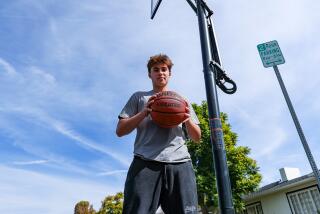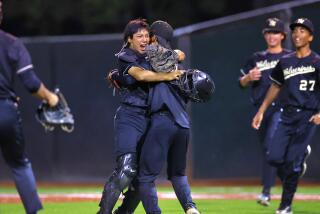Great Scott : Loyola Hurler has Relief Work Down to a Science
A poster of probable future Hall of Fame pitcher Tom Seaver hangs on the wall in Darryl Scott’s apartment, reminding the Loyola Marymount reliever of how Seaver transformed pitching into a five-step science.
“He had each step memorized,” Scott marveled last week, basking in the sun in the stands at Loyola’s Page Stadium. “It was just perfect.”
That science of pitching is being revived in the most unlikely of characters--the short relief pitcher.
Slowly but surely, sophomore Scott is developing into the consummate stopper without an exploding fastball or a bottomless curve, the usual tools of a short man. Scott uses pitching’s newest sensation, the split-finger fastball. It leaves hitters kicking the dirt as they lunge at what looks like a fastball and drops like a rock.
“He’s really the opposite of what you’d consider a normal reliever,” said Loyola starting pitcher Scott Neill. “He doesn’t throw hard and isn’t intense. He’s laid-back and calm. That’s probably what makes him so good. He has no ups and downs.”
Scott had a 3-2 mark with 6 saves, 26 strikeouts and a 2.97 earned run average through last Sunday’s 3-0 loss to Cal State Fullerton. Not the most impressive credentials. But when you consider that the 6-1, 205-pound right-hander began the fall as a starter after working short relief last season out of necessity and again became the short man on short notice this winter, Scott’s numbers look better.
“He is not at the point where he was last year because I think changing roles has confused him,” said pitcher Brian Clancy.
Scott started during the fall because the coaches were hoping junior Kalani Bush would develop into a stopper, which he did. But when Bush returned to Loyola in December from his home in Hawaii, his sinker wasn’t sinking, so the alarm sounded for last season’s fireman.
“We didn’t have anybody to fill that role,” said Coach Dave Snow, “and we didn’t have much of a choice.
“The luxury of having Darryl,” Snow said, “is that he’s solid and can either start or relieve. It’s a big plus.”
The strain of a two-game-a-week schedule sandwiched between four-game weekend series from now until the end of West Coast Athletic Conference play means Scott will likely be called on often to put out fires and possibly start when the Lions four-man rotation breaks down.
Scott needs to use only the two fastballs as a reliever. As a starter, he is forced to rely also on a less effective curve and change-up to keep hitters off balance. Last season he posted eight wins against six losses with three saves, 66 strikeouts and a team-leading 4.28 ERA in a school-record 34 appearances, mostly in relief.
“How many short relievers do you see that are even halfway normal?” he asked. “I think you have to be funny in the head. I feel like I have the short-man kind of thinking. I like the tempo that I can get out of the pen, onto the mound and into a situation.”
Scott came to Loyola from Yuba City, a small town about 40 miles north of Sacramento, where he became a three-year letterman in baseball as well as basketball. He figured he’d see less than 30 innings of middle relief during his first year as a Lion.
“And all of a sudden, I’m a stopper,” he remembered. “I never had time to think about it. I really didn’t have it in my mind that my role was a stopper. That’s just what I did.”
Neill said, “It was kind of like trial by fire” for the freshman Scott. “He had to learn by being in there.”
“Usually as a freshman you just get your feet wet,” said Clancy, who usually precedes Scott in relief. “Darryl kind of got his whole body wet.”
Scott and catcher Miah Bradbury played in an Alaskan amateur league last summer. What is known as “the midnight sun game” kept Scott pitching long after normal league play was over. Games started at 11 p.m. and lights were prohibited.
Varying sunlight and shadows played havoc with hitters. “It never got dark,” Scott said. “You’d see the sun go down and come up again during the game.”
Scott visited his mother in Alaska during the two previous summers. This summer he’ll play for Harwich, Mass., of the Cape Cod League under assistant Loyola coach Bill Springman.
By September, he will have played essentially three seasons in 12 months. Yet all of the work and his mid-80 m.p.h. velocity will still leave him short of pro baseball, according to Snow.
“What (pro) scouts look for is a God-given arm and Darryl doesn’t have that,” Snow said. “In the pros, he’ll get an opportunity if he is able to show that he can throw a number of pitches over the plate in a good location and get people out.”
The Lions felt Scott had proved enough last season to warrant team most valuable pitcher honors, but Snow said Scott has much to learn. Pitching Coach Jim Benedict, a former reliever in the Kansas City Royals and Atlanta Braves organizations, provides some education.
“He has helped me in thinking about what I have to do,” Scott said.
More than anything this year at Loyola, Scott’s mental approach and field consistency provide immeasurable team confidence because, said Benedict, “he thinks he is gonna get every guy out, and he is the only guy on the staff like that. The whole staff is centered around getting to a point where we can use him.”
The responsibility has left Scott determined to bring more than just his throwing arm onto the mound in tough situations.
“I want to carry a presence out there to lift the team,” he said. “Goose Gossage brought out a presence that said he was the best and no one was gonna hit him. If I go out with a (negative) attitude, it pulls everyone else down. Everyone is looking at the pitcher, and the presence he brings onto the mound is what everybody else picks up.”
More to Read
Get our high school sports newsletter
Prep Rally is devoted to the SoCal high school sports experience, bringing you scores, stories and a behind-the-scenes look at what makes prep sports so popular.
You may occasionally receive promotional content from the Los Angeles Times.






